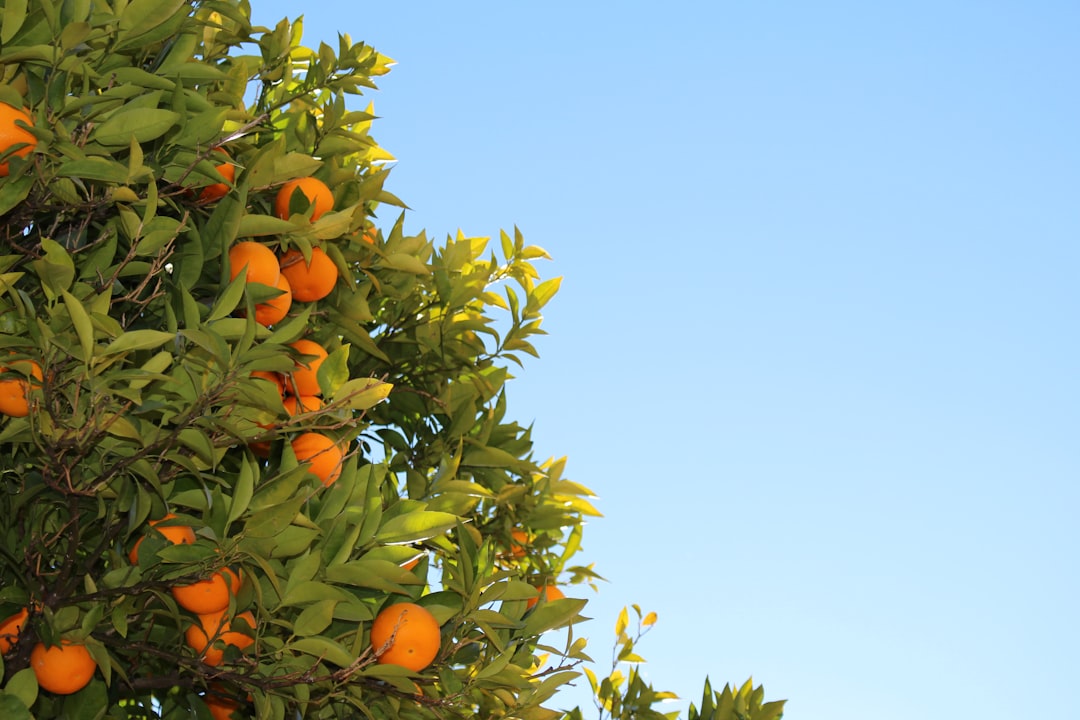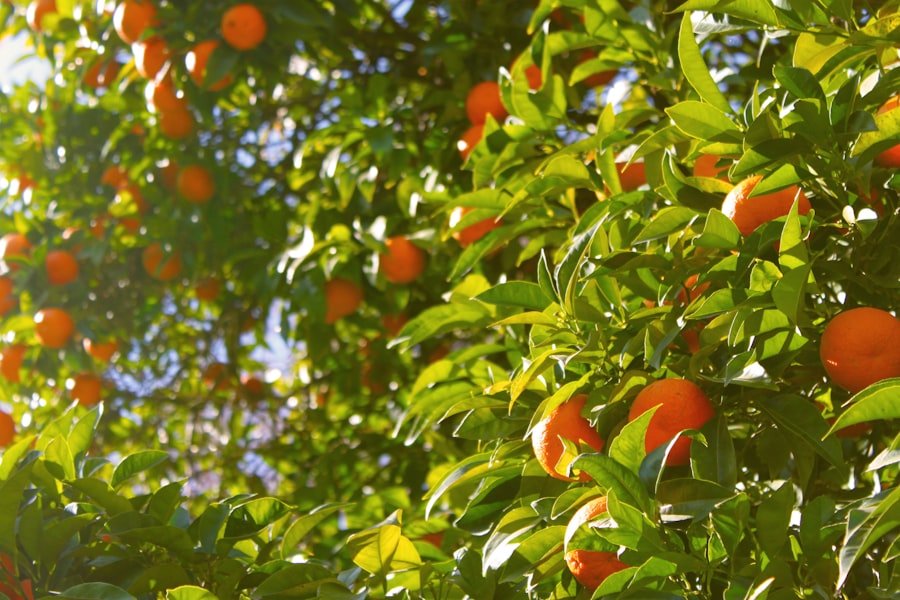Planting an Orange Tree: A Step-by-Step Guide

Growing orange trees has become increasingly popular among homeowners due to the numerous benefits of having fresh oranges readily available at home. Not only do orange trees provide a beautiful addition to any landscape, but they also offer a bountiful harvest of delicious and nutritious fruit. Whether you have a large backyard or a small patio, growing an orange tree can be a rewarding and enjoyable experience.
Key Takeaways
- Choose a location with full sun and well-draining soil for your orange tree.
- Prepare the soil by removing weeds and adding organic matter before planting.
- Select a variety of orange tree that is suited for your climate and soil type.
- When purchasing and transporting your orange tree, make sure to keep the roots moist and avoid damaging the trunk or branches.
- Dig a hole that is twice as wide as the root ball and at the same depth as the soil in the container when planting your orange tree.
Choosing the Right Location for Your Orange Tree
When selecting a location for your orange tree, it is crucial to choose an area that receives full sun exposure. Orange trees thrive in sunny conditions and require at least six to eight hours of direct sunlight each day to produce healthy fruit. Additionally, it is important to ensure that the chosen location has good drainage to prevent waterlogged soil, which can lead to root rot and other diseases.
Another factor to consider when choosing a location for your orange tree is its size and proximity to other plants or structures. Orange trees can grow quite large, so it is essential to select a location that allows for adequate space for the tree to reach its full size without being crowded by other plants or obstructed by nearby structures.
Preparing the Soil for Planting
Before planting your orange tree, it is essential to prepare the soil properly. Start by testing the soil pH to determine if any amendments are needed. Orange trees prefer slightly acidic soil with a pH range of 6.0 to 7.0. If the soil pH is too high or too low, you can adjust it by adding amendments such as sulfur or lime.
In addition to adjusting the soil pH, adding organic matter to the soil is highly beneficial for orange trees. Organic matter improves soil structure, enhances nutrient availability, and promotes beneficial microbial activity. You can incorporate organic matter into the soil by adding compost or well-rotted manure before planting.
Selecting the Best Orange Tree Variety for Your Area
| Variety Name | Climate Suitability | Fruit Size | Seedless | Harvest Time |
|---|---|---|---|---|
| Washington Navel | Mild to Warm | Large | Yes | December to February |
| Valencia | Warm to Hot | Medium to Large | No | March to June |
| Cara Cara | Mild to Warm | Medium | Yes | December to March |
| Blood Orange | Mild to Warm | Medium | Yes | December to March |
Choosing the right orange tree variety for your area is crucial for successful growth and fruit production. Different varieties of orange trees have specific climate and soil requirements, so it is essential to select a variety that is suited for your particular region.
Some popular orange tree varieties include Valencia, Navel, and Blood Orange. Valencia oranges are known for their sweet and juicy flavor, making them perfect for fresh eating or juicing. Navel oranges are seedless and have a slightly tangy taste, making them ideal for snacking. Blood oranges have a unique red flesh and a sweet yet slightly tart flavor, making them a favorite among citrus enthusiasts.
Purchasing and Transporting Your Orange Tree
When purchasing an orange tree, it is important to buy from a reputable nursery to ensure that you are getting a healthy and disease-free tree. Look for a nursery that specializes in citrus trees and has a good reputation for providing quality plants.
Transporting your orange tree safely is crucial to prevent damage to the tree’s roots or branches. When transporting the tree, make sure to secure it properly in your vehicle to prevent it from shifting or falling over. Avoid exposing the tree to extreme temperatures or direct sunlight during transportation.
Digging the Hole for Your Orange Tree

Digging the right hole for your orange tree is essential for its successful establishment and growth. The hole should be deep and wide enough to accommodate the tree’s root ball comfortably. A general rule of thumb is to dig a hole that is twice as wide and just as deep as the root ball.
To prepare the hole, loosen the soil at the bottom of the hole with a garden fork or shovel. This will help the roots penetrate the soil more easily. Adding compost or organic matter to the hole can also improve soil fertility and drainage.
Planting Your Orange Tree: Best Practices
When planting your orange tree, it is important to follow best practices to ensure its successful establishment. Place the tree in the hole at the same depth it was planted in the nursery container. Backfill the hole with soil, gently firming it around the roots to eliminate air pockets.
After planting, water the tree thoroughly to settle the soil and provide moisture to the roots. It is important to water the tree regularly, especially during the first year of growth, to promote healthy root development.
Watering and Fertilizing Your Orange Tree
Proper watering and fertilization are essential for the health and productivity of your orange tree. Orange trees require regular and deep watering to ensure that the roots receive adequate moisture. Water deeply once or twice a week, depending on weather conditions and soil type.
When it comes to fertilizing your orange tree, it is important to use a balanced fertilizer specifically formulated for citrus trees. Apply fertilizer in early spring and again in late summer or early fall. Avoid over-fertilization, as this can lead to excessive vegetative growth at the expense of fruit production.
Pruning Your Orange Tree for Optimal Growth
Pruning your orange tree is necessary to promote healthy growth, maintain its shape, and improve fruit production. Pruning should be done during the dormant season, typically in late winter or early spring.
When pruning your orange tree, start by removing any dead or diseased branches. Next, thin out any crowded or crossing branches to improve air circulation and sunlight penetration. Finally, shape the tree by selectively pruning branches to maintain a balanced and open canopy.
Protecting Your Orange Tree from Pests and Diseases
Monitoring your orange tree for pests and diseases is crucial for its long-term health and productivity. Common pests that can affect orange trees include aphids, scale insects, and citrus leaf miners. Regularly inspect your tree for signs of infestation, such as distorted leaves or sticky residue on the leaves.
To prevent pest infestations, you can use organic insecticides or introduce beneficial insects that feed on pests. Additionally, practicing good sanitation by removing fallen leaves and fruit can help reduce the risk of disease.
Harvesting and Enjoying Your Fresh Oranges
Harvesting your oranges at the right time is essential to ensure optimal flavor and sweetness. Oranges are typically ready for harvest when they reach their full color and are easily detached from the tree with a gentle twist. Avoid picking oranges when they are still green or underripe, as they will not ripen properly off the tree.
Once harvested, store your oranges in a cool and dry place away from direct sunlight. They can be stored at room temperature for up to a week or refrigerated for longer shelf life. Fresh oranges can be enjoyed as a healthy snack, juiced, or used in various culinary applications.
Growing your own orange tree can be a rewarding and enjoyable experience that provides you with an abundant supply of fresh and delicious fruit. By choosing the right location, preparing the soil properly, selecting the best variety for your area, and following best practices for planting and care, you can successfully grow an orange tree in your own backyard. So why wait? Start growing your own orange tree today and enjoy the taste of freshly picked oranges right at home.
If you’re interested in learning more about planting an orange tree, you might find this article from Lawn World helpful. They provide a comprehensive guide on how to plant and care for orange trees, ensuring a successful harvest of delicious citrus fruits. Check out their article on how to plant an orange tree for step-by-step instructions and expert tips. For more gardening resources, you can also explore their sitemap. Happy planting!
FAQs
What is the best time to plant an orange tree?
The best time to plant an orange tree is in the spring or fall when the weather is mild and the soil is moist.
What type of soil is best for planting an orange tree?
Orange trees prefer well-draining soil that is rich in organic matter. A soil pH between 6.0 and 7.5 is ideal for growing orange trees.
How much sunlight does an orange tree need?
Orange trees need full sun exposure for at least 6 hours a day to produce fruit. Plant the tree in a location that receives plenty of sunlight.
How often should I water my orange tree?
Water your orange tree deeply once a week during the growing season. Reduce watering during the winter months when the tree is dormant.
What type of fertilizer should I use for my orange tree?
Use a balanced fertilizer with equal amounts of nitrogen, phosphorus, and potassium. Apply the fertilizer in the spring and summer months.
How do I prune my orange tree?
Prune your orange tree in the late winter or early spring before new growth appears. Remove any dead or diseased branches and thin out the canopy to improve air circulation.
When can I expect my orange tree to produce fruit?
Orange trees typically start producing fruit 2-3 years after planting. The tree will continue to produce fruit for many years with proper care and maintenance.



